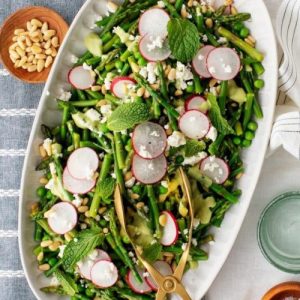Fresh, vibrant, and nourishing, this asparagus salad is the perfect celebration of spring flavors.
Packed with fiber-rich veggies, plant-based protein from peas, and heart-healthy fats from avocado and pine nuts, it’s as nutritious as it is delicious.
Light on carbs and low in saturated fat, this dish is quick to prepare, satisfying for any meal, and versatile enough for everyday cooking or meal prep.

Asparagus Salad
Equipment
- 1 Large pot (for blanching asparagus)
- 1 Large mixing bowl (for seasoning and tossing vegetables)
- 1 Medium bowl (for ice water)
- 1 sharp knife for chopping vegetables
- 1 cutting board
- 1 Kitchen towel or paper towels (for drying asparagus)
- 1 whisk (for mixing dressing)
- 1 Serving platter
Ingredients
- 2 bunches asparagus tender parts, cut into 1-inch pieces
- 1 tablespoon extra-virgin olive oil
- 1 tablespoon fresh lemon juice
- ½ clove garlic finely grated
- ½ teaspoon sea salt
- ¼ teaspoon freshly ground black pepper or to taste
- 1 cup peas frozen, thawed, or fresh blanched
- ⅓ cup feta cheese crumbled (optional for vegan version)
- 3 radishes thinly sliced
- ¼ cup pine nuts lightly toasted
- 2 –3 tablespoons avocado dressing store-bought or homemade
- 2 tablespoons fresh mint or basil leaves for garnish
Instructions
- Prepare the asparagus: Bring a large pot of salted water to a gentle boil. While waiting, fill a medium bowl with ice water and set it aside. Once the water boils, add the asparagus pieces and blanch them for about 1 minute until they turn bright green and slightly tender. Quickly transfer the asparagus into the ice water to stop the cooking process. Let it sit for a minute, then drain thoroughly and pat dry with a clean kitchen towel to remove excess moisture.
- Make the seasoning base: In a large mixing bowl, whisk together the olive oil, fresh lemon juice, grated garlic, sea salt, and black pepper. This simple mixture creates a bright, zesty base that lightly coats the vegetables and enhances their fresh spring flavor.
- Season the vegetables: Add the blanched asparagus and thawed peas to the bowl with the dressing. Toss gently to ensure every piece is evenly coated. This step not only seasons the vegetables but also helps them absorb the citrus and garlic notes for a refreshing taste.
- Assemble the salad: Transfer the seasoned vegetables to a serving platter. Drizzle the avocado dressing over the top, allowing it to coat the veggies lightly without overwhelming them. Scatter thin slices of radish across the platter, then sprinkle on crumbled feta, toasted pine nuts, and a handful of fresh mint or basil leaves.
- Serve and enjoy: Taste and adjust the seasoning if needed. Serve immediately as a light lunch, a refreshing spring side dish, or alongside your favorite protein for a balanced meal. This salad is best enjoyed fresh, while the vegetables are crisp and the herbs are fragrant.
Notes
- Blanching asparagus briefly keeps it crisp and bright green.
- Ice water stops cooking instantly to lock in freshness.
- Whisking the dressing base first ensures even flavor coating.
- Toasted pine nuts add depth and crunch.
- Feta provides a salty balance to creamy avocado dressing.
- Radishes contribute color and peppery crispness.
- Fresh herbs lift the flavors at the end.
- The salad is versatile—serve as side or main.
- Can be made partly ahead (prep dressing, chop veggies).
- Best enjoyed fresh, but can hold for short storage.
Chef’s Secrets for Perfect Salad
The secret to a standout asparagus salad lies in proper preparation of the vegetables.
Blanching the asparagus for just one minute keeps it tender yet crisp, and shocking it in ice water prevents overcooking and preserves its vibrant color.
Always pat the asparagus dry before tossing—it prevents sogginess and helps the dressing cling beautifully.
Toast your pine nuts in a dry skillet until golden to bring out their nutty richness.
Finally, add fresh herbs right before serving; they wilt quickly but give the salad a fragrant lift that makes it unforgettable.
Serving Suggestions and Pairing Ideas
This salad shines as a fresh side dish with almost any spring meal.
It pairs beautifully with grilled proteins like salmon, chicken, or tofu, as well as pasta dishes such as spaghetti aglio e olio or creamy fettuccine.
For plant-based eaters, roasted chickpeas or edamame can boost the protein content while maintaining the salad’s lightness.
It also makes a refreshing picnic or brunch dish—just keep the herbs separate until the last minute to maintain their brightness.
For a complete lunch, serve with crusty bread or a light soup on the side.
Storage Tips and Make-Ahead Advice
This salad tastes best fresh, but you can prepare some components in advance to save time.
The avocado dressing can be made a day ahead and kept refrigerated in a sealed jar.
Blanch the asparagus up to 12 hours in advance, then store it in an airtight container lined with a paper towel to absorb moisture.
Assemble the salad just before serving for maximum freshness.
If you have leftovers, store them in the refrigerator for up to one day—note that the dressing may soften the veggies, so keep it separate if planning for storage.
Frequently Asked Questions
1. Can I use frozen asparagus instead of fresh?
Fresh asparagus is highly recommended for this recipe because of its crisp texture and bright flavor.
Frozen asparagus tends to be softer and may not hold up as well in a salad, but it can be used in a pinch if blanched very briefly.
2. What can I substitute for feta cheese?
If you want a dairy-free option, skip the feta and use marinated tofu cubes, vegan feta, or even a handful of pickled radishes.
These substitutions maintain the balance of tang and saltiness in the salad.
3. How do I keep the avocado dressing from browning?
Avocado-based dressings are prone to oxidation, which turns them brown.
Adding lemon juice slows the process, but for best results, store the dressing in an airtight jar with plastic wrap pressed against the surface to minimize air contact.
4. Can this salad be meal-prepped for the week?
It’s not the best candidate for long-term meal prep, since the fresh vegetables and herbs lose their crispness.
However, you can prep individual components like dressing, blanched asparagus, and chopped radishes ahead of time, then assemble quickly when needed.
5. What proteins go well with this salad?
This dish is versatile and pairs well with grilled chicken, salmon, or shrimp for non-vegetarians.
Plant-based options include roasted chickpeas, seared tempeh, or quinoa, which complement the salad while adding staying power and extra nutrition.

